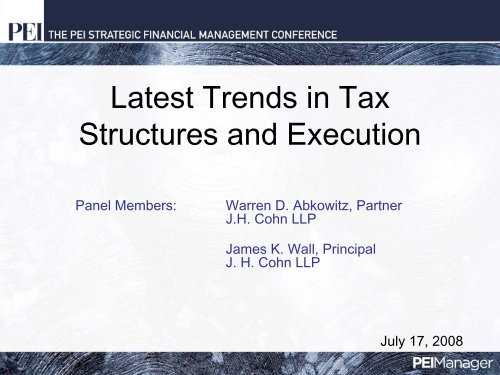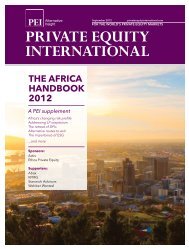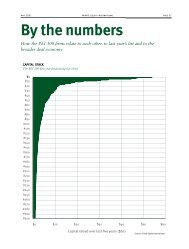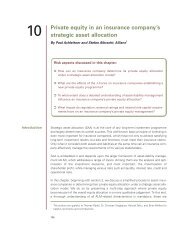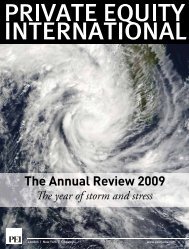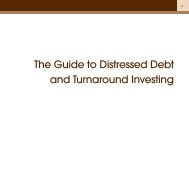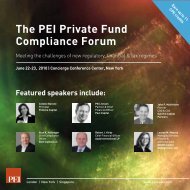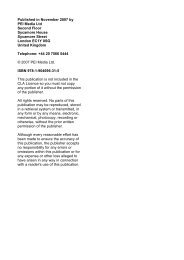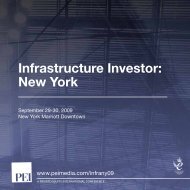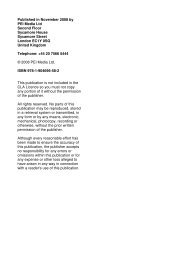Latest Trends in Tax Structures and Execution - PEI Media
Latest Trends in Tax Structures and Execution - PEI Media
Latest Trends in Tax Structures and Execution - PEI Media
Create successful ePaper yourself
Turn your PDF publications into a flip-book with our unique Google optimized e-Paper software.
<strong>Latest</strong> <strong>Trends</strong> <strong>in</strong> <strong>Tax</strong><br />
<strong>Structures</strong> <strong>and</strong> <strong>Execution</strong><br />
Panel Members:<br />
Warren D. Abkowitz, Partner<br />
J.H. Cohn LLP<br />
James K. Wall, Pr<strong>in</strong>cipal<br />
J. H. Cohn LLP<br />
July 17, 2008
Carried Interests<br />
• Profits Interest vs. Capital Interest<br />
• Requirements:<br />
– Received for past or future services.<br />
– Not a capital <strong>in</strong>terest.<br />
• Exceptions:<br />
– Substantially certa<strong>in</strong> <strong>in</strong>come stream<br />
– Interest disposed of with<strong>in</strong> two years<br />
– Interest is <strong>in</strong> publicly traded partnership<br />
• Revenue Procedures 93-27 (vested <strong>in</strong>terest) <strong>and</strong> 2001-43<br />
(Non-vested <strong>in</strong>terest) (Current law).<br />
1
Carried Interests<br />
• Sol Diamond case – 1971 Partnership<br />
<strong>in</strong>terest is taxable upon receipt.<br />
• Campbell case – 1990 Partnership <strong>in</strong>terest<br />
would be taxable but can’t accurately value<br />
profits <strong>in</strong>terest.<br />
• IRS tried to use liquidation value as taxable<br />
value but profit <strong>in</strong>terest holders do not receive<br />
proceeds upon immediate liquidation.<br />
2
Publicly Traded Partnerships<br />
• Publicly Traded Partnerships (PTP) --<br />
–Traded on established securities market or readily tradable on<br />
secondary market (i.e., <strong>in</strong>terest has liquidity)<br />
–<strong>Tax</strong>ed as a corporation – current 35% federal <strong>in</strong>come tax rate.<br />
•Exceptions.<br />
–Private Placements: Unregistered Offer<strong>in</strong>g <strong>and</strong> Less than 100<br />
partners.<br />
–Qualify<strong>in</strong>g Income Exemption: If 90% or more of gross <strong>in</strong>come<br />
of entity is certa<strong>in</strong> qualify<strong>in</strong>g <strong>in</strong>come <strong>in</strong>clud<strong>in</strong>g <strong>in</strong>come from real<br />
estate <strong>and</strong> natural resource activities as well as from <strong>in</strong>terest,<br />
dividends <strong>and</strong> sale of capital assets (cap ga<strong>in</strong>s).<br />
3
Legislative Proposals<br />
•Recent Rangel <strong>Tax</strong> Bills:<br />
- H.R. 3970 (<strong>Tax</strong> Reduction <strong>and</strong> Reform Act of<br />
2007) (October 25, 2007) (a.k.a. “Mother of All <strong>Tax</strong><br />
Legislation”).<br />
- H.R. 3996 (Temporary <strong>Tax</strong> Relief Act of 2007)<br />
(October 31, 2007).<br />
- H.R. 6275 (June 17, 2008).<br />
4
Legislative Proposals<br />
GOOD NEWS<br />
•Repeal (H.R. 3970) or Reduction (H.R. 3996)<br />
of AMT for <strong>in</strong>dividuals.<br />
•Unrelated Bus<strong>in</strong>ess <strong>Tax</strong>able Income (UBTI).<br />
5
Legislative Proposals<br />
BAD NEWS<br />
•Carried Interests (<strong>and</strong> Other Services Interests).<br />
•Self-Employment <strong>Tax</strong>es.<br />
•Unrelated Bus<strong>in</strong>ess <strong>Tax</strong>able Income (UBTI).<br />
•Section 197 Intangible Amortization.<br />
•Dividend Received Deduction.<br />
6
Legislative Proposals<br />
CARRIED INTERESTS<br />
•Any allocable net <strong>in</strong>come or ga<strong>in</strong> attributable to an “<strong>in</strong>vestment<br />
services partnership <strong>in</strong>terest” (i.e. carried <strong>in</strong>terest) would be<br />
ord<strong>in</strong>ary <strong>in</strong>come.<br />
•A partner is treated as hold<strong>in</strong>g an “<strong>in</strong>vestment services<br />
partnership <strong>in</strong>terest” if (i) the person renders <strong>in</strong>vestment advisory<br />
services (advis<strong>in</strong>g as to purchase or sale, management, f<strong>in</strong>anc<strong>in</strong>g<br />
or any activity <strong>in</strong> support of the forego<strong>in</strong>g) to the partnership (ii)<br />
with respect to stock, publicly-traded partnership <strong>in</strong>terests, debt<br />
<strong>in</strong>struments, notional pr<strong>in</strong>cipal contracts, currency or <strong>in</strong>terest rate<br />
contracts/swaps, real estate, actively-traded commodities <strong>and</strong><br />
options or derivative contracts with respect to the above.<br />
7
Legislative Proposals<br />
CARRIED INTERESTS<br />
•Invested Capital Exception. An exception applies where the<br />
<strong>in</strong>vestment service partner <strong>in</strong>vests capital for the <strong>in</strong>terest <strong>and</strong> the<br />
person is allocated <strong>in</strong>come with respect to the capital portion on a<br />
pari passu basis with other the <strong>in</strong>vested capital by other partners.<br />
•Invested capital for a service partner excludes proceeds of a loan<br />
or debt guaranteed by another partner.<br />
•Invested capital for a non-service partner <strong>in</strong>cludes any loan made<br />
or guaranteed by such non-service partner; (affects <strong>in</strong>come<br />
allocated to <strong>in</strong>vested capital).<br />
8
Legislative Proposals<br />
MANAGEMENT SERVICES INTERESTS<br />
•Any <strong>in</strong>come or ga<strong>in</strong> recognized with respect to a “disqualified<br />
<strong>in</strong>terest” would be ord<strong>in</strong>ary <strong>in</strong>come where the taxpayer renders<br />
“<strong>in</strong>vestment management services” to the entity <strong>and</strong> the value of<br />
the <strong>in</strong>terest is substantially related to the amount of <strong>in</strong>come or ga<strong>in</strong><br />
from the assets with respect to such services performed.<br />
•Disqualified Interest mean any <strong>in</strong>terest <strong>in</strong> any entity other than a<br />
partnership <strong>in</strong>terest or stock <strong>in</strong> a domestic C Corporation or certa<strong>in</strong><br />
foreign corporations.<br />
•Investment Management Services means a substantial quantity of<br />
any of the advisory services noted above under Investment<br />
Services Partnership Interests.<br />
9
<strong>Tax</strong>-Exempt Investors<br />
•Income of US tax-exempt <strong>in</strong>vestors generally not<br />
subject to US federal <strong>in</strong>come tax, except for “unrelated<br />
bus<strong>in</strong>ess taxable <strong>in</strong>come” (UBTI), which is subject to<br />
tax at regular corporate rates.<br />
•UBTI is gross <strong>in</strong>come derived from any “unrelated<br />
trade or bus<strong>in</strong>ess… regularly carried on” by the taxexempt,<br />
less any deductions associated with such<br />
trade or bus<strong>in</strong>ess.<br />
10
<strong>Tax</strong>-Exempt Investors (cont’d)<br />
•Certa<strong>in</strong> “passive” <strong>in</strong>come items, <strong>in</strong>clud<strong>in</strong>g dividends, <strong>in</strong>terest <strong>and</strong><br />
capital ga<strong>in</strong>, are excluded from UBTI.<br />
•Income otherwise taxable to “US shareholders” of CFCs is also<br />
excluded from UBTI.<br />
•However, if <strong>in</strong>vestment property yield<strong>in</strong>g dividends, <strong>in</strong>terest or<br />
other excludable <strong>in</strong>come is leveraged, it may result <strong>in</strong> such <strong>in</strong>come<br />
becom<strong>in</strong>g “unrelated debt f<strong>in</strong>anced <strong>in</strong>come” which is a separate<br />
category of UBTI.<br />
11
<strong>Tax</strong>-Exempt Investors (cont’d)<br />
•Thus, allocable share of <strong>in</strong>come from PE Fund<br />
potentially taxable to tax-exempt <strong>in</strong>vestor if: (1)<br />
Portfolio Company is <strong>in</strong> “pass-through” form<br />
(e.g., partnership, LLC) <strong>and</strong> engaged <strong>in</strong> nonexempt<br />
bus<strong>in</strong>ess OR (2) Portfolio Company is<br />
<strong>in</strong> corporate form, but <strong>in</strong>vestment there<strong>in</strong> is<br />
leveraged.<br />
12
<strong>Tax</strong>-Exempt Investors (cont’d)<br />
Potential solutions to UBTI:<br />
•Imposition of additional capital contribution obligations on taxexempt<br />
<strong>in</strong>vestors, <strong>in</strong>stead of proportionate share of debt leverage<br />
otherwise used by PE Fund to <strong>in</strong>vest <strong>in</strong> Portfolio company.<br />
–Frequently impracticable, imposes additional capital burden on taxexempt<br />
<strong>in</strong>vestor, with result<strong>in</strong>g drag on cash flow/IRR<br />
•Use of “blocker corporation” to shelter UBTI otherwise earned at<br />
PE Fund level.<br />
13
<strong>Tax</strong>-Exempt Investors (cont’d)<br />
•Foreign blocker corporation <strong>in</strong> effect “blocks” the<br />
<strong>in</strong>come <strong>and</strong> activities of the PE Fund or its Portfolio<br />
companies from giv<strong>in</strong>g rise to UBTI.<br />
•Provided a tax-favorable offshore jurisdiction is<br />
chosen, the blocker corp should not be subject to non-<br />
US corporate level taxation.<br />
•Blocker corp may be subject to US tax (at corporate<br />
rates) <strong>in</strong> respect of its share of <strong>in</strong>come from Portfolio<br />
Company.<br />
•Blocker structures frequently organized as “above-thefund”<br />
or “below-the-fund”.<br />
14
<strong>Tax</strong>-Exempt Investors (cont’d)<br />
Blocker Corporation Structure (“above-the-fund”)<br />
<strong>Tax</strong>able US<br />
Investors<br />
Blocker<br />
Corporation<br />
<strong>Tax</strong>-Exempt<br />
Investors<br />
Fund<br />
Portfolio<br />
Companies<br />
15
<strong>Tax</strong>-Exempt Investors (cont’d)<br />
•“Above-the-fund” blocker structure contemplates<br />
<strong>in</strong>vestment of tax-exempts’ capital <strong>in</strong>to Blocker Corp,<br />
which then contributes to PE Fund.<br />
•This structure protects tax-exempts from potential<br />
UBTI result<strong>in</strong>g from:<br />
–PE Fund <strong>in</strong>vestments <strong>in</strong> pass-through entities,<br />
whose unrelated bus<strong>in</strong>ess status would otherwise<br />
pass through to tax-exempt.<br />
–Debt leverage imposed at the PE Fund level.<br />
16
<strong>Tax</strong>-Exempt Investors (cont’d)<br />
Blocker Corporation Structure (“below-the-fund”)<br />
<strong>Tax</strong>able US<br />
Investors<br />
<strong>Tax</strong>-Exempt<br />
Investors<br />
Fund<br />
Blocker<br />
Corporation<br />
Portfolio<br />
Companies<br />
17
<strong>Tax</strong>-Exempt Investors (cont’d)<br />
•“Below-the-fund” blocker structure contemplates <strong>in</strong>vestment by<br />
tax-exempts directly <strong>in</strong>to PE Fund, which re<strong>in</strong>vests that capital <strong>in</strong>to<br />
a wholly-owned Blocker Corp. PE fund <strong>and</strong> Blocker Corp then co<strong>in</strong>vest<br />
aggregate capital (from taxable <strong>and</strong> tax-exempt <strong>in</strong>vestors,<br />
respectively) <strong>in</strong>to Portfolio Companies.<br />
•This structure permits direct <strong>in</strong>vestment by PE Fund <strong>in</strong>to passthrough<br />
Portfolio Companies, as well as <strong>in</strong>currence of debt<br />
leverage at Portfolio Company level, without creat<strong>in</strong>g UBTI to taxexempts.<br />
18
<strong>Tax</strong>-Exempt Investors (cont’d)<br />
Parallel Fund Structure<br />
<strong>Tax</strong>able<br />
Investors<br />
General<br />
Partner<br />
<strong>Tax</strong>-exempt<br />
Investors<br />
Fund<br />
(Delaware)<br />
Fund<br />
(non-US)<br />
Portfolio<br />
Company<br />
Portfolio<br />
Company<br />
Portfolio<br />
Company<br />
19
<strong>Tax</strong>-Exempt Investors (cont’d)<br />
•A Parallel Fund structure essentially permits tax-exempt <strong>in</strong>vestors<br />
to <strong>in</strong>vest <strong>in</strong> a PE fund “side-by-side” with taxable <strong>in</strong>vestors, through<br />
an offshore entity designed to act as a conduit for the tax-exempts’<br />
capital contributions <strong>and</strong> <strong>in</strong>vestment returns.<br />
•The offshore <strong>in</strong>vestment vehicle will frequently be a “reversehybrid”<br />
entity that is treated as a pass-through for local tax<br />
purposes, but is treated as a corporation for US tax purposes.<br />
•This structure <strong>in</strong> effect uses a blocker entity that is utilized <strong>in</strong> a<br />
fund that is exclusively devoted to the tax-exempt <strong>in</strong>vestors.<br />
20
Foreign Investors <strong>in</strong> PE/Hedge Funds – General Concepts<br />
•Investment Funds are most typically organized as pass through entities for US tax<br />
purposes (LP’s or LLC’s); If the Investment Fund is organized outside the US, the<br />
entity classification rules <strong>and</strong> entity classification considerations are critical<br />
- Allows for s<strong>in</strong>gle level of tax for US <strong>in</strong>vestors<br />
- Allows for pass through of lower tax rate <strong>in</strong>come<br />
-LTCG<br />
- Qualified dividends<br />
•If the Investment Fund is engaged <strong>in</strong> a US trade or bus<strong>in</strong>ess (“ETB”), foreign<br />
partners will be as well (Section 875)<br />
•Foreign Investors <strong>in</strong> such structures are subject to US Federal <strong>in</strong>come tax (<strong>and</strong><br />
allocable State taxes) on their share of <strong>in</strong>come effectively connected with such<br />
trade or bus<strong>in</strong>ess (“ECI”)<br />
- 1446 withhold<strong>in</strong>g applies<br />
- Branch tax may apply<br />
- US <strong>Tax</strong> Return fil<strong>in</strong>gs required<br />
•Any ga<strong>in</strong> realized on the disposition of a partnership <strong>in</strong>terest is also ECI (See Rev<br />
Rule 91-32)<br />
- This Revenue Rul<strong>in</strong>g has been widely criticized<br />
21
Foreign Investors <strong>in</strong> PE/Hedge Funds – US Source FDAP<br />
•In cases where Investment Funds do not generate ECI, direct foreign <strong>in</strong>vestors are<br />
generally only subject to US withhold<strong>in</strong>g taxes on US source FDAP <strong>in</strong>come.<br />
–This may arise where the activities of the fund fall with<strong>in</strong> the 864(b)(2) trad<strong>in</strong>g<br />
<strong>in</strong> securities or commodities exception<br />
•Withhold<strong>in</strong>g taxes can be reduced or elim<strong>in</strong>ated via treaty or statutory exemptions<br />
(e.g. portfolio debt <strong>in</strong>struments).<br />
–Note that procedural requirements must be complied with <strong>in</strong> order for the<br />
exemptions to apply<br />
•The adm<strong>in</strong>istrative burdens of comply<strong>in</strong>g with US Source FDAP withhold<strong>in</strong>g<br />
requirements can be burdensome for both withhold<strong>in</strong>g agents <strong>and</strong> foreign<br />
<strong>in</strong>vestors.<br />
–W-8BEN forms <strong>and</strong> W-8IMY for foreign flow through entities<br />
–US Source FDAP withhold<strong>in</strong>g applies on a cash basis generally but must be<br />
completed even without a payment by the time a K-1 is due (see 1.1441-5(2))<br />
22
Foreign Investors <strong>in</strong> PE/Hedge Funds – ECI<br />
•Investment <strong>in</strong>come generally does not create ECI (e.g. dividends, <strong>in</strong>terest<br />
<strong>and</strong> most capital ga<strong>in</strong>s).<br />
–Capital ga<strong>in</strong>s <strong>in</strong>volv<strong>in</strong>g USRPIs are a major exception<br />
•Fee <strong>in</strong>come is one of the primary sources of ECI.<br />
–Debt or equity commitment fees<br />
–Break-up fees<br />
–Transaction Fees<br />
–Guaranty Fees<br />
–Monitor<strong>in</strong>g fees<br />
•If the Investment Fund <strong>in</strong>vests <strong>in</strong> another pass-through entity that is ETB,<br />
the Investment Fund’s foreign <strong>in</strong>vestors may realize ECI.<br />
23
Foreign Investors <strong>in</strong> PE/Hedge Funds – Plann<strong>in</strong>g<br />
•How do foreign <strong>in</strong>vestors <strong>in</strong> <strong>in</strong>vestment funds with ECI m<strong>in</strong>imize exposure<br />
to US tax?<br />
–Blocker companies<br />
–US Blocker companies elim<strong>in</strong>ate 1446 withhold<strong>in</strong>g but may lead to<br />
double level tax (US corporate tax at the blocker company level <strong>and</strong><br />
withhold<strong>in</strong>g taxes on distributions)<br />
–Foreign Blocker companies <strong>in</strong>sulate foreign shareholders but the<br />
foreign Blocker company will suffer entity level taxes (branch tax may<br />
be an issue)<br />
–Blocker Companies may be above the fund, below the fund or<br />
parallel blocker structures (the structures are often used for both<br />
foreign <strong>and</strong> tax exempt <strong>in</strong>vestors)<br />
•Management fee offsets allow the fund Manager to take all the “bad” fee<br />
<strong>in</strong>come (rather than the <strong>in</strong>vestment fund itself) with a compensat<strong>in</strong>g<br />
adjustment to the periodic management fee payable to the fund Manager.<br />
–Assignment of <strong>in</strong>come may be an issue<br />
24
Foreign Investors <strong>in</strong> PE/Hedge Funds – Plann<strong>in</strong>g<br />
•Blocker companies can be comb<strong>in</strong>ed with leverage structured as portfolio<br />
debt.<br />
–This type of structure makes it difficult for foreign <strong>in</strong>vestors to share<br />
<strong>in</strong> profits equally with US <strong>in</strong>vestors<br />
–Need to be m<strong>in</strong>dful of cont<strong>in</strong>gent debt rules <strong>and</strong> 10% shareholders<br />
that could cause portfolio debt requirements not to be met.<br />
•Options <strong>and</strong> swaps are often considered as plann<strong>in</strong>g techniques to avoid<br />
ECI <strong>and</strong> US withhold<strong>in</strong>g taxes but many technical issues need to be<br />
addressed.<br />
–An option on an LLC <strong>in</strong>terest (that itself would generate ECI) would<br />
need to be a capital asset <strong>and</strong> the sale of the option not treated as<br />
the sale of the LLC <strong>in</strong>terest itself<br />
–Total Return Swaps generally need to be structured as notional<br />
pr<strong>in</strong>cipal contracts <strong>and</strong> certa<strong>in</strong> other requirements met<br />
25
Foreign Investors <strong>in</strong> PE/Hedge Funds – Plann<strong>in</strong>g<br />
•US Real estate funds have special issues because dispositions or<br />
USRPI’s generate ECI under the FIRPTA rules.<br />
–REIT structures may be advantageous for foreign <strong>in</strong>vestors<br />
–Shared Appreciation Loans also have advantages s<strong>in</strong>ce<br />
FIRPTA only “kicks <strong>in</strong>” on the disposition of the loan.<br />
•Treasury is consider<strong>in</strong>g changes to the ECI rules.<br />
–It is not clear, if <strong>and</strong> when such changes would be made <strong>and</strong><br />
what they would ultimately look like<br />
–ECI plann<strong>in</strong>g is likely to cont<strong>in</strong>ue to be important to foreign<br />
<strong>in</strong>vestors <strong>in</strong> Investment Funds<br />
26
Investments <strong>in</strong> Foreign Portfolio Companies<br />
• The goal is generally to reduce the overall effective<br />
tax rate (US <strong>and</strong> Foreign)<br />
– Less tax means better returns for <strong>in</strong>vestors<br />
• Common plann<strong>in</strong>g techniques <strong>in</strong>clude:<br />
– Basis step-up<br />
• 338 elections<br />
• Local country step-up plann<strong>in</strong>g<br />
– Leverage<br />
• Need to be m<strong>in</strong>dful of “th<strong>in</strong> cap” rules<br />
• License <strong>in</strong>tangibles to high tax jurisdictions<br />
– Achiev<strong>in</strong>g local country consolidation<br />
– CTB elections to m<strong>in</strong>imize subpart F<br />
27


